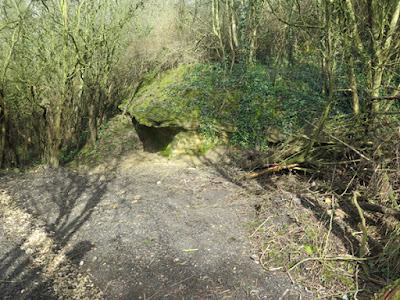 |
| A coal seam |
Continuing along Greenway West, the characteristics of the limestone remain essentially unchanged, with thinner beds predominating, but with occasional massive beds that are weathered to a ‘honeycomb’ texture.
 |
| A general view |
Apart from the rippled surfaces on some of beds of thin limestone, there are no obvious sedimentary structures, but vertical joints appear regularly along the section, which are frequently exploited by tree roots. I can't recall seeing any faults, although there is one place near the escarpment that is downwarped slightly.
 |
| A joint filled by a root |
In a few places where thin beds of marl appear in the limestone, small springs form with boggy areas at the base of the cutting, around which sphagnum moss and various other water loving plants are flourishing.
 |
| A spring with bog loving plants |
One very interesting feature of the Cadeby Formation here, is the complete absence of bryozoan reefs, which I have seen at several places further to the north in South Yorkshire, such as Maltby Crags, North Cliff Quarry and Anston Stones Wood.
Before we knew it, the old railway line had passed from solid rock to a railway embankment and, partially hidden by undergrowth and trees, there was an old quarry on the north of the track, where a large block of sandstone from the Yellow Sands Formation outcrops at its entrance.
A thickness of nearly 7 metres was recorded here, in the geological memoir, with the top metre being described as well cemented and quite hard. The large sample that I collected, although quite friable, remained intact in my rucksack for the rest of our walk.
At this point, we could have easily stopped and turned back to Clowne; however, although appearing as a small isolated outcrop a few hundred metres further to the west, I had been informed by Chris Darmon that it was well worth making the effort to go look at a coal seam.
 |
| The limestone escarpment |
The trees alongside the old railway largely obscure the surrounding landscape but, taking advantage of an occasional viewpoint, I was interested to see that a quick walk had taken us some distance from the escarpment.
 |
| The coal seam |
Finally arriving at the coal seam, which is one of a handful that I can recall seeing – despite having lived in the middle of a coal mining district for 25 years and surveyed very many geological sites in South Yorkshire. We all thought that the site could benefit from sensitive clearance of vegetation and an interpretation board, given its rarity value.




Thank you for this very interesting information.
ReplyDeleteThank you too for your comment...
ReplyDelete